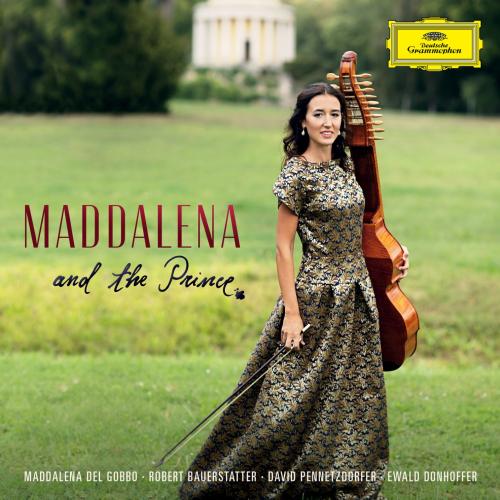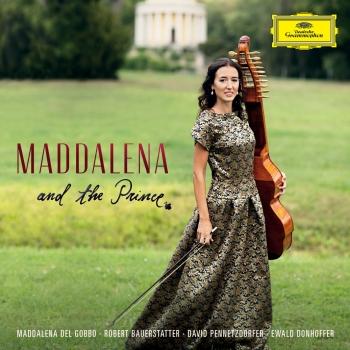
Maddalena And The Prince Maddalena Del Gobbo, Robert Bauerstatter, David Pennetzdorfer, Ewald Donhoffer
Album info
Album-Release:
2019
HRA-Release:
26.07.2019
Label: Universal Music
Genre: Classical
Subgenre: Chamber Music
Artist: Maddalena Del Gobbo, Robert Bauerstatter, David Pennetzdorfer, Ewald Donhoffer
Composer: Franz Xaver Hammer (1741-1817), Andreas Lidl (1740-1789), Franz Joseph Haydn (1732-1809)
Album including Album cover
I`m sorry!
Dear HIGHRESAUDIO Visitor,
due to territorial constraints and also different releases dates in each country you currently can`t purchase this album. We are updating our release dates twice a week. So, please feel free to check from time-to-time, if the album is available for your country.
We suggest, that you bookmark the album and use our Short List function.
Thank you for your understanding and patience.
Yours sincerely, HIGHRESAUDIO
- Franz Joseph Haydn (1732 - 1809): Baryton Trio No.113 in D:
- 1 Baryton Trio No.113 in D: 1. Adagio 05:39
- 2 Baryton Trio No.113 in D: 2. Allegro di molto 02:34
- 3 Baryton Trio No.113 in D: 3. Menuet: Allegretto 02:42
- Andreas Lidl (1740 - 1789): Divertimento No. 3 in G Major for Baryton, Viola and Violoncello:
- 4 Divertimento No. 3 in G Major for Baryton, Viola and Violoncello: 1. Moderato 03:25
- 5 Divertimento No. 3 in G Major for Baryton, Viola and Violoncello: 2. Andante 05:06
- 6 Divertimento No. 3 in G Major for Baryton, Viola and Violoncello: 3. Presto 01:56
- Franz Xaver Hammer (1741 - 1817): Sonata No. 1 in A Major for Viola da Gamba and Harpsichord:
- 7 Sonata No. 1 in A Major for Viola da Gamba and Harpsichord: 1. Adagio 04:53
- 8 Sonata No. 1 in A Major for Viola da Gamba and Harpsichord: 2. Allegro (tempo giusto) 05:14
- 9 Sonata No. 1 in A Major for Viola da Gamba and Harpsichord: 3. Menuetto 03:13
- 10 Sonata No. 1 in A Major for Viola da Gamba and Harpsichord: 4. Rondo (scherzando) 02:30
- 11 Sonata No. 1 in A Major for Viola da Gamba and Harpsichord: 5. Hongarese 00:45
- Franz Joseph Haydn: Divertimento No. 27 in D Major for Baryton, Viola and Violoncello:
- 12 Divertimento No. 27 in D Major for Baryton, Viola and Violoncello: 1. Adagio cantabile 04:28
- 13 Divertimento No. 27 in D Major for Baryton, Viola and Violoncello: 2. Allegro di molto 03:10
- 14 Divertimento No. 27 in D Major for Baryton, Viola and Violoncello: 3. Menuet (Allegretto) - Trio - Menuet 02:22
- Luigi Tomasini (1741 - 1808): Trio in C Major for Baryton, Viola and Violoncello (Kor. 19):
- 15 Trio in C Major for Baryton, Viola and Violoncello (Kor. 19). 1. Allegro spiritoso 03:01
- 16 Trio in C Major for Baryton, Viola and Violoncello (Kor. 19). 2. Menuetto - Trio - Menuetto 02:47
- 17 Trio in C Major for Baryton, Viola and Violoncello (Kor. 19). 3. Rondo (Allegretto) 03:01
- Franz Joseph Haydn: Baryton Trio No.97 in D "Fatto per la felicissima nascita di S:Ai:S Prencipe Estorhazi":
- 18 Baryton Trio No.97 in D "Fatto per la felicissima nascita di S:Ai:S Prencipe Estorhazi": 1. Adagio cantabile 05:35
- 19 Baryton Trio No.97 in D "Fatto per la felicissima nascita di S:Ai:S Prencipe Estorhazi": 2. Allegro di molto 02:38
- 20 Baryton Trio No.97 in D "Fatto per la felicissima nascita di S:Ai:S Prencipe Estorhazi": 3. Menuet 02:38
- 21 Baryton Trio No.97 in D "Fatto per la felicissima nascita di S:Ai:S Prencipe Estorhazi": 4. Polonaise 01:18
- 22 Baryton Trio No.97 in D "Fatto per la felicissima nascita di S:Ai:S Prencipe Estorhazi": 5. Adagio 01:21
- 23 Baryton Trio No.97 in D "Fatto per la felicissima nascita di S:Ai:S Prencipe Estorhazi": 6. Menuet 01:36
- 24 Baryton Trio No.97 in D "Fatto per la felicissima nascita di S:Ai:S Prencipe Estorhazi": 7. Fuga: Presto 01:47
Info for Maddalena And The Prince
Join me in dipping into the world of Prince Nikolaus Esterházy, who was known as “the Magnificent”, and his beloved music. The baritone, the instrument on this album, is also magnificent: six (gut) strings to be bowed, nine or more resonating strings (made of metal), a carved head atop the neck, delicate ornamentation and a noble, graceful sound.
Maddalena and the Prince: the prince being Nikolaus Esterházy as well as the noble instrument – in my opinion the baritone is the “prince” of instruments, which can produce the loveliest and most charming sound and whose appearance alone makes hearts leap.
The thrill of recording these works in the Haydnsaal of the Esterházy Palace, drinking in the atmosphere of this magical location while playing, was an unforgettable experience for me and one for which I am truly grateful.
Maddalena Del Gobbo is the only Deutsche Grammophon Viola da Gamba recording artist. An award winning musician, she has performed extensively across Europe and in Asia.
Maddalena first came in contact with the viola da gamba when she entered a record shop on the heart of Vienna and was mesmerized by an enchanting sound she would never forget. She still finished her studies as a cellist, received a MA and performed in many concert halls as a soloist and chamber musician. All this time, she never forgot the viol and secretly honed her skills until, one day, she decided to make the viol her focal point and to dedicate her life to baroque music.
Maddalena Del Gobbo was born in Italy and started studying music at a very early age. At the age of four, she began learning the piano and gradually added the cello and singing to her musical education. At 13 years old, her unusual talent brought her to Vienna, where she studied the cello at the Konservatorium Wien Privatuniversität.
“Sensuality, brilliance and an utterly perfect technique” (Heinz Sichrovsky, NEWS (Austria)
"This album charts a significant but little-documented episode in the history of Western music, the decade-long obsession of Prince Nikolaus Esterházy for the baritone. The instrument is a Baroque-era elaboration of the viola da gamba, similar in shape and with seven gut playing strings, which are bowed and stopped at frets. But the baritone also has 10 sympathetic strings, which run under the fingerboard. A hole in the back of the neck allows the player to pluck these strings with the thumb of the left hand, and in the Baroque era, music for baritone often consisted of a bowed melody line accompanied by a plucked thorough bass." (Fanfare magazine)
Maddalena Del Gobbo, baritone, viola da gamba
Robert Bauerstatter, viola
David Pennetzdorfer, cello
Ewald Donhoffer, harpsichord (Tracks 7–11)
Maddalena Del Gobbo
Maddalena was born in Italy and started studying music at a very early age. At 13 her musical talent brought her to Vienna, where she studied cello at the Vienna Conservatory. She first came in contact with the viola da gamba when she entered a record shop in the heart of Vienna and was mesmerized by an enchanting sound she would never forget. She later decided to make the viol her focal point and to dedicate her life to baroque music.
This album contains no booklet.











